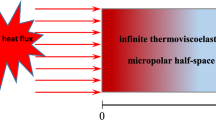Abstract
A coupled thermomechanical model for the propagation of a stationary chemical-reaction wave in a condensed medium is developed. Stresses and strains that arise during the reaction as a result of thermal and “concentration” expansion of the material are related by Maxwell’s equations for a viscoelastic medium. The expression for the heat flux is written as a generalized Fourier law with finite relaxation time for the heat flux. It is shown that deformation of the material in the reaction zone can lead to an apparent change in the activation energy, heat effect, and other characteristics of the system. This model allows for the existence of two different — subsonic and supersonic — regimes of propagation of the front, as well as the model in which the stress- and strain-tensor components are related by a generalized Hooke’s law.
Similar content being viewed by others
References
A. M. Timokhin and A. G. Knyazeva, “Reaction-front propagation regimes in a coupled thermomechanical model of solid-state combustion,”Khim. Fiz.,15, No. 10, 1497–1514 (1996).
A. G. Knyazeva “Velocity of the simplest solid-state chemical reaction front and internal mechanical stresses,”Fiz. Goreniya Vzryva,30, No. 1, 44–54 (1994).
A. G. Knyazeva and E. A. Dyukarev, “Stationary wave of a chemical reaction in a deformable medium with finite relaxation time of the heat flux,”Fiz. Goreniya Vzryva,31, No. 3, 38–46 (1995).
E. A. Dyukarev and A. G. Knyazeva, “Thermomechanical model of autowave propagation of low temperature reactions with regard to fracture,” in: Proc. of 16th Int. Colloquium on the Dynamics of Explosions and Reactive Systems (August 3–8, 1997, Cracov. Poland), (1997), pp. 263–265.
B. Boley and J. Winer,Theory of Thermal Stresses, Wiley, New York (1960).
V. S. Eremeev,Diffusion and Stresses [in Russian], Énergoatomizdat, Moscow (1984).
A. G. Knyazeva,Introduction to the Locally Equilibrium Thermodynamics of Physicochemical Reactions in Deformable Media [in Russian]. Izd. Tomsk. Univ., Tomsk (1996).
V. A. Podergin,Metallothermic Systems [in Russian], Metallurgiya, Moscow (1982).
N. S. Enikolopov, “Solid-state chemical reactions and new technologies,”Usp. Khim.,16, No. 3, 586–594 (1991).
I. P. Bazarov,Thermodynamics [in Russian], Vysshaya Shkola, Moscow (1991).
H. Eyring, S. H. Lin, and S. M. Lin.Basic Chemical Kinetics [Russian translation] Mir, Moscow (1983).
L. I. Sedov,Mechanics of Continuous Media [in Russian], Vol. 1. Nauka, Moscow (1973).
S. P. Timoshenko and J. Goodier.Theory of Elasticity, McGraw-Hill, New York (1970).
N. I. Nikitenko,Coupled and Inverse Problems of Heat and Mass Transfer [in Russian], Naukova Dumka, Kiev (1988).
V. F. Gribanov and N. G. Panichkin.Coupled and Dynamic Problems of Thermoelasticity [in Russian], Mashinostroenie, Moscow (1984).
S. L. Sobolev, “Transfer processes and traveling waves in locally nonequilibrium systems,”Usp. Fiz. Nauk,161, No. 3, 5–29 (1991).
B. V. Novozhilov, “Propagation velocity of a chemical-reaction front in a condensed phase,”Dokl. Akad. Nauk SSSR,141, No. 1, 151–153 (1961).
N. S. Enikolopyan and A. A. Mkhitaryan, “Low-temperature detonation waves in solids,”Dokl. Akad. Nauk SSSR,309, No. 2, 384–387 (1989).
V. M. Kholopov and S. I. Khudyaev, “Nonuniqueness of a stationary combustion wave,”Mat. Model.,10, No. 5, 91–108 (1988).
V. S. Berman, “Propagation of the front of an exothermicn-stage sequential reaction,”Fiz. Goreniya Vzryva,11, No. 5, 693–702 (1975).
V. K. Smolyakov, E. A. Nekrasov, and Yu. M. Maksimov, “Simulation of gasless combustion with phase transformations,”Fiz. Goreniya Vzryva,20, No. 2, 63–73 (1984).
E. A. Nekrasov amd A. M. Timokhin, “Theory of thermal wave propagation of multistage reactions described by simple empirical schemes,”Fiz. Goreniya Vzryva,22, No. 4, 48–54 (1986).
T. P. Ivleva, A. G. Merzhanov, and K. G. Shkadinskii “New type of nonuniqueness of stationary regimes of combustion wave propagation,”Dokl. Akad. Nauk SSSR,256, No. 4, 897–900 (1981).
A. G. Knyazeva and V. T. Kuznetsov, “Failure of the surface layer of nitroglycerin powder during ignition at various initial temperatures,”Fiz. Goreniya Vzryva,31, No. 4, 10–19 (1995).
A. G. Knyazeva and E. A. Dyukarev, “Model of detonation of lead azide (PbN3) with regard to fracture,”Int. J. Fracture,100, No. 2, 197–205 (1999).
Author information
Authors and Affiliations
Additional information
Translated fromFizika Goreniya i Vzryva, Vol. 36, No. 4. pp. 41–51, July–August, 2000.
Rights and permissions
About this article
Cite this article
Knyazeva, A.G., Dyukarev, E.A. Model for the propagation of a stationary reaction front in a viscoelastic medium. Combust Explos Shock Waves 36, 452–461 (2000). https://doi.org/10.1007/BF02699475
Received:
Revised:
Issue Date:
DOI: https://doi.org/10.1007/BF02699475




